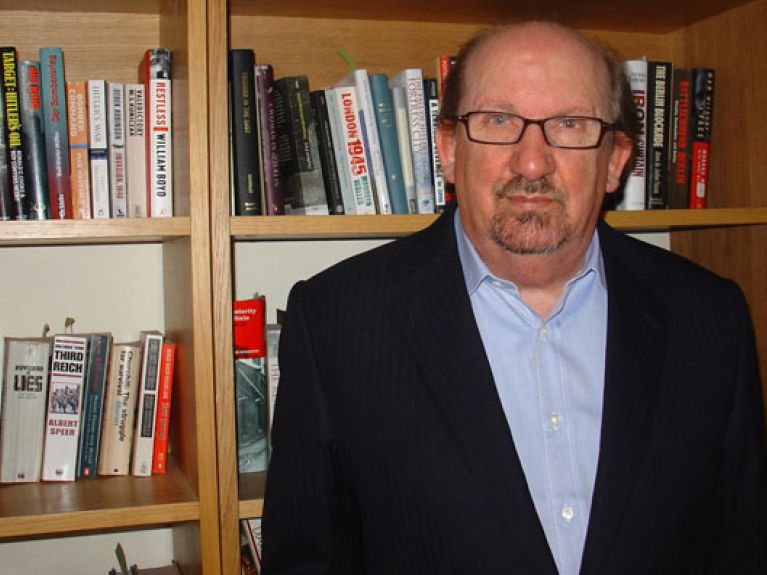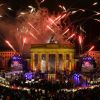Europe’s second chance
A dossier marking the 25th anniversary of the Fall of the Berlin Wall. In part 3, Germany expert and book author Frederick Taylor explains why today it’s imperative that we learn our lessons from the events in the run-up to and immediately following the Wall coming down.

Mr. Taylor, do you remember what you were doing on 9 November 1989, the day the Wall came down?
Curiously, I was unaware of it until 10 November 1989. On the evening of 9 November my wife and I had travelled to London, where a friend had lent us his apartment. As it turned out, his television was out of order, and since we were tired from our journey we went straight to bed. Only the next morning did I realise what had happened in Berlin. I was delighted but, of course, disappointed to have missed the “live” experience.
As you write in your book, the Wall created stability to the benefit of other peoples. What did the Wall coming down spell for world events in the years that followed?
Well, for the victors of World War 2, the “stability” created by the Wall was quite convenient. Not so for Germans, or for the other nations trapped within the Soviet sphere of rule. Obviously the Wall coming down ended the Cold War, and made possible the kind of globalised economy we now experience. It also made the world political situation more fluid, with all the implications, both good and bad, of such fluidity.
You are British. What changes did the Wall coming down bring for the everyday life of you and other people outside Germany?
On the positive side, it meant a joyful sense of a new, open Europe. We got to know Eastern Europeans once more, and they us. On the negative side, I think the end of the Cold War, in which solidarity against the communist threat had acted as a binding element, slowly allowed the resurgence of old European nationalisms, which now seem a “cost-free” indulgence. Not so much in Germany, actually, but in other countries, including my own. A bad mistake, as we may yet be forced to learn.
Current events in the Ukraine are an example that the process of political convergence between Germany and east and west Europe is by no means complete. From your viewpoint, what have been the key turning points in world politics and main achievements on the convergence agenda since 1989?
It’s a very difficult situation. Gaps have opened up once more between East and West. German reunification, EU expansion, and the retreat of Russian power could in principle have made the possibility of future convergence conceivable. However, current events demonstrate that the issue of the power of Russia has not been solved, and indeed will not be solved for as long as Putin and his allies remain involved. Should there be attempts at convergence made in the future, it will be a more fraught and more hesitant process than we hoped (and believed) back in 1989. I fear that the major events in world politics since 2000 – the rise of violent religious extremism in particular – will slow down convergence on a world scale, though in the long run such a process seems all but inevitable.
The Wall lives on, among other things in culture the world over. Countless works have addressed it, even before 1989. There’s the book “The Spy Who Came In From The Cold” by John Le Carré and albums such as Lou Reed’s “Berlin” and Pink Floyd’s “The Wall”. What importance do you attach to artistic remembrance world-wide?
Part of the reason why the Wall appeared artistically so influential was because it represented a shocking but fascinating example of how in a modern city, in a modern country, such a barbaric and extreme structure could first be built and then become “normal”. I think it’s worth continuing to remember the Wall, above all thorough art, music and literature, because this memory acts as a warning of the terrible things we Europeans can do to each other.
East Side Gallery in Berlin is one example of the great fascination that the way the Wall divided Germany exerts on people the world over. Why is it still such a crowd-puller?
Well, it’s right on the old border between East and West. It’s got some striking and provocative images (not all original!). And it’s practically speaking all that remains of the old Wall – unless you know where to look in out of the way parts of Berlin and its hinterland. The East Side Gallery – and the Brandenburg Gate – are the Wall’s symbolic places, and people need such places.
What is the importance of a world-wide culture of remembrance of 9 November 1989?
25 years ago, with the fall of the Wall, Europe was almost miraculously delivered from its historic mistakes (by which I mean two great and bloody wars) and given a second chance. We haven’t, perhaps, used that chance as wisely as we might have. But it hasn’t all been negative, and there is still hope of a real European rebirth. How to use this anniversary? We should take a deep breath and vow to keep on trying.
Frederick Taylor
British historian Frederick Taylor (born 1947) studied Modern History and German in Oxford and Munich. During the 1970s he spent time in both East and West Germany. He won international recognition for his books on the Berlin Wall and the Dresden bombings in World War II. In his new book “Inflation” he demonstrates how the dramatic depreciation in the value of the Reichsmark between 1914 and 1923 caused the downfall of the young Weimar Republic. Taylor lives in Cornwall together with his wife, the writer Alice Kavounas, and is a Fellow of the Royal Historical Society.
